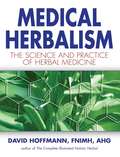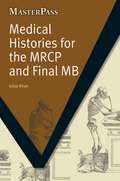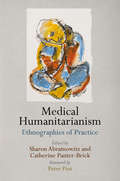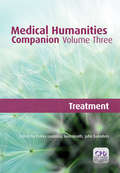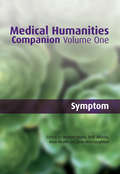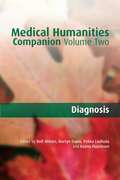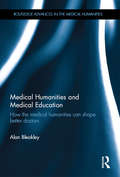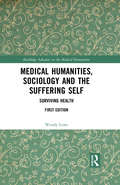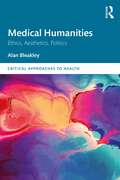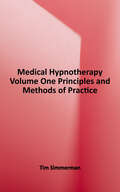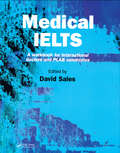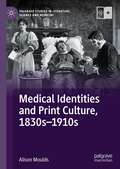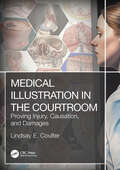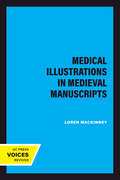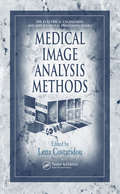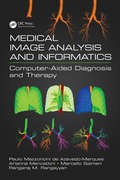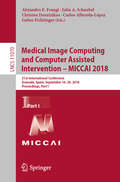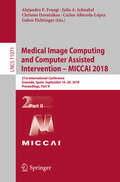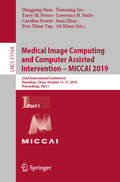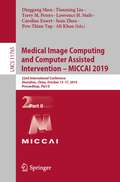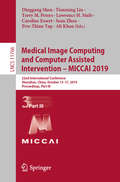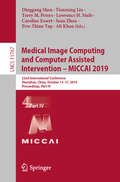- Table View
- List View
Medical Herbalism: The Science and Practice of Herbal Medicine
by David HoffmannA foundational textbook on the scientific principles of therapeutic herbalism and their application in medicine• A complete handbook for the medical practitioner• Includes the most up-to-date information on preparations, dosage, and contraindications• By the author of The Complete Illustrated Holistic HerbalMedical Herbalism contains comprehensive information concerning the identification and use of medicinal plants by chemical structure and physiological effect, the art and science of making herbal medicine, the limitations and potential of viewing herbs chemically, and the challenge to current research paradigms posed by complex plant medicines. It also includes information on toxicology and contraindications, the issues involved in determining dosage and formulation types for an individual, guides to the different measurement systems and conversion tables, and the pros and cons of both industrial and traditional techniques.With additional sections devoted to the principles of green medicine, the history of Western Herbalism, the variety of other medical modalities using medicinal plants, an extensive resource directory, and a discussion of treatments organized by body system, Medical Herbalism is the comprehensive textbook all students and practitioners of clinical herbalism need to develop their healing practices.
Medical Histories for the MRCP and Final MB (MasterPass)
by Zafar Iqbal Iqbal KhanTaking a patient's medical history is a vital skill often overlooked by junior doctors and medical students, leading to a worryingly high failure rate in the PACES and OSCE exams. Don't be caught out! This book has been specifically designed to give you invaluable guidance and practice for taking medical histories. It features 50 complete case studies, including referral letters, medical histories, suggested data gathering methods, points to consider, warning signs, management of uncomfortable topics and differential diagnosis. With a focus on the importance and benefits of role-play in revision, this concise and easy to read format provides the study aid for Membership of the Royal College of Physicians (MRCP) candidates sitting their Objective Structured Clinical Examination (OSCE) and Practical Assessment of Clinical Examination Skills (PACES) examinations. It is also of great benefit to undergraduates approaching their final year examinations.
Medical History Education for Health Practitioners
by Alannah Tomkins Lisett Lovett'Twenty-first century medicine is just the current stage of a never-ending journey of tremendous complexity. Those of us who are fortunate enough to practise in this day and age do so in ways that are themselves the results of huge changes over many centuries - advances in areas such as medication and surgical and imaging techniques and developments in our understanding of the human body and its attendant threats through genetics. Add to that list the huge social and societal changes in public health, attitudes to illness and changes in ethical viewpoints, and we find ourselves at the current forefront of medical evolution but nowhere near the end of this particular journey.' From the Foreword by Paul Lazarus This fascinating book brings to life the history of medicine in Britain since 1600. Throughout the historical account the authors cover mainstream clinical issues but also make reference to the importance of literature and art, presenting a wide-ranging view of the past. It also incorporates milestones in other cultures and epochs, where appropriate, for a balanced overview. The concise, self-contained sections are a joy to read and can be easily dipped into. The majority of chapters include suggested questions for students, assisting group discussion. It is ideal for medical and healthcare course organisers, lecturers and tutors who require a rapid resource of information in their subject area - be it cardiovascular disease, emergency medicine or child protection - to provide context, interest and entertainment for their students. It is also highly recommended as the basis for a programme of seminars on the history of medicine.
Medical Humanitarianism: Ethnographies of Practice (Pennsylvania Studies in Human Rights)
by Catherine Panter-Brick Peter Piot Sharon AbramowitzMedical humanitarianism—medical and other health-related initiatives undertaken in conditions born of conflict, neglect, or disaster —has a prominent and growing presence in international development, global health, and human security interventions. Medical Humanitarianism: Ethnographies of Practice features twelve essays that fold back the curtains on the individual experiences, institutional practices, and cultural forces that shape humanitarian practice. <P><P>Contributors offer vivid and often dramatic insights into the experiences of local humanitarian workers in the Afghan-Pakistan border areas, national doctors coping with influxes of foreign humanitarian volunteers in Haiti, military doctors working for the British Army in Iraq and Afghanistan, and human rights-oriented volunteers within the Israeli medical bureaucracy. They analyze our contested understanding of lethal violence in Darfur, food crises responses in Niger, humanitarian knowledge in Ugandan IDP camps, and humanitarian departures in Liberia. <P><P>They depict the local dynamics of healthcare delivery work to alleviate human suffering in Somali areas of Ethiopia, the emergency metaphors of global health campaigns from Ghana to war-torn Sudan, the fraught negotiations of humanitarians with strong state institutions in Indonesia, and the ambiguous character of research ethics espoused by missions in Sierra Leone. In providing well-grounded case studies, Medical Humanitarianism will engage both scholars and practitioners working at the interface of humanitarian medicine, global health interventions, and the social sciences. They challenge the reader to reach a more critical and compassionate understanding of humanitarian assistance. <P><P>Contributors: Sharon Abramowitz, Tim Allen, Ilil Benjamin, Lauren Carruth, Mary Jo DelVecchio-Good, Alex de Waal, Byron J. Good, Stuart Gordon, Jesse Hession Grayman, Jean-Hervé Jézéquel, Peter Locke, Amy Moran-Thomas, Patricia Omidian, Catherine Panter-Brick, Peter Piot, Peter Redfield, Laura Wagner.
Medical Humanities
by Thomas R. Cole Nathan S. Carlin Ronald A. Carson Thomas R. Cole Nathan S. CarlinThis textbook brings the humanities to students in order to evoke the humanity of students. It helps to form individuals who take charge of their own minds, who are free from narrow and unreflective forms of thought, and who act compassionately in their public and professional worlds. Using concepts and methods of the humanities, the book addresses undergraduate and premed students, medical students, and students in other health professions, as well as physicians and other healthcare practitioners. It encourages them to consider the ethical and existential issues related to the experience of disease, care of the dying, health policy, religion and health, and medical technology. Case studies, images, questions for discussion, and role-playing exercises help readers to engage in the practical, interpretive, and analytical aspects of the material, developing skills for critical thinking as well as compassionate care.
Medical Humanities Companion, Volume 3
by John Saunders Iona Heath Pekka LouhialaThis third volume in the Companion to Medical Humanities series considers the concept of treatment as an active process which produces an outcome, be it effective, inappropriate or inadequate. It invites the reader to examine the relevance of the patients' belief in any given treatment and their confidence in the practitioner. Against a person-cent
Medical Humanities Companion: v. 1
by Iona Heath Martyn Evans Rolf Ahlzen Jane MacNaughtonThe phrase 'medical humanities' has a currency that is wider than any agreement as to what it means, though those engaged in the field usually know what they are attempting. This volume examines the idea of 'symptom' as a route to understanding the structure of clinical practice. Actual symptoms are always experienced by real, actual individuals - however much those experiences are mediated by language, culture, expectation and the conventions of the clinical consultation. And this in turn is important because it reminds us that health, illness, well-being, suffering are first and foremost aspects of experience. This book asks questions - and offers answers - about the meaning of actual symptoms and of the concept of 'symptom' as a prelude to a cumulative interdisciplinary understanding of illness as a source of human need, and clinical medicine as a human response to it.
Medical Humanities Companion: v. 2
by Martyn Evans Rolf Ahlzen Raimo PuustWhen a person falls ill, their experience changes - sometimes in a very minor and transient way, sometimes in a decisive and lasting one. 'Diagnosis' is often seen as the process of scientifically and objectively identifying the causes of this subjective experience, but is the process and meaning of 'diagnosis' really as simple as this implies? As this volume of The Medical Humanities Companion argues, diagnoses are an answer to complex human needs that spring from being ill, and are in turn a complex, culturally mediated interaction between individuals, scientific discoveries, social negotiation and historical change. This volume makes visible the complexities and ambiguities involved in giving and receiving diagnoses, and how they shape and are shaped by views on what is real and acceptable, and how people relate to the phenomena of illness.
Medical Humanities and Medical Education: How the medical humanities can shape better doctors (Routledge Advances in the Medical Humanities)
by Alan BleakleyThe field of the medical humanities is developing rapidly, however, there has also been parallel concern from sceptics that the value of medical humanities educational interventions should be open to scrutiny and evidence. Just what is the impact of medical humanities provision upon the education of medical students? In an era of limited resources, is such provision worth the investment? This innovative text addresses these pressing questions, describes the contemporary territory comprising the medical humanities in medical education, and explains how this field may be developed as a key medical education component for the future. Bleakley, a driving force of the international movement to establish the medical humanities as a core and integrated provision in the medical curriculum, proposes a model that requires collaboration between patients, artists, humanities scholars, doctors and other health professionals, in developing medical students’ sensibility (clinical acumen based on close noticing) and sensitivity (ethical, professional and humane practice). In particular, this text focuses upon how medical humanities input into the curriculum can help to shape the identities of medical students as future doctors who are humane, caring, expressive and creative – whose work will be technically sound but considerably enhanced by their abilities to communicate well with patients and colleagues, to empathise, to be adaptive and innovative, and to act as ‘medical citizens’ in shaping a future medical culture as a model democracy where social justice is a key aspect of medicine. Making sense of the new wave of medical humanities in medical education scholarship that calls for a ‘critical medical humanities’, Medical Humanities and Medical Education incorporates a range of case studies and illustrative and practical examples to aid integrating medical humanities into the medical curriculum. It will be important reading for medical educators and others working with the medical education community, and all those interested in the medical humanities.
Medical Humanities, Sociology and the Suffering Self: Surviving Health (Routledge Advances in the Medical Humanities)
by Wendy LoweFollowing criticisms of the traditionally polarized view of understanding suffering through either medicine or social justice, Lowe makes a compelling argument for how the medical humanities can help to go beyond the traditional biographical and epistemic breaks to see into the nature and properties of suffering and what is at stake. Lowe demonstrates through analysis of major healthcare workforce issues and incidence of burnout how key policies and practices influence healthcare education and experiences of both patients and health professionals. By including first person narratives from health professionals as a tool and resource, she illustrates how dominant ideas about the self enter practice as a refusal of suffering. Demonstrating the relationship between personal experience, theory and research, Lowe argues for a pedagogy of suffering that shows how the moral anguish implicit in suffering is an ethical response of the emergent self. This is an important read for all those interested in medical humanities, health professional education, person-centred care and the sociology of health and illness.
Medical Humanities: Ethics, Aesthetics, Politics (Critical Approaches to Health)
by Alan BleakleyThis ground-breaking book sets out a fresh vision for a future medical education by providing a radical reconceptualisation of the purposes of medical humanities through a lens of critical health psychology and liberatory pedagogy. The medical humanities are conceived as translational media through which reductive, instrumental biomedicine can be raised in quality, intensity, and complexity by embracing ethical, aesthetic, political, and transcendental values. This translation occurs through innovative use of metaphor. A note of caution is offered – that the medical humanities too can be instrumental and reductive if not framed well. Drawing on major theorists such as Michel Foucault and Jacques Rancière and bringing together insights from diverse but inter-related fields, Bleakley focuses on the "ills" of contemporary biomedicine and medical education, and the need for reconceptualisation, which – it is argued – the translational medical humanities have the potential to accomplish. Current instrumental approaches to medical humanities, embracing communication skills training and narrative-based medicine, have failed to address the chronic symptoms suffered by medicine. These include resort to closed, functional systems thinking rather than embracing dynamic, complex, open, and adaptive systems thinking; lack of democratic habits in medical culture, compromising patient safety and care; the production of insensibility rather than deepening of sensibility in medical education; a lack of attention to ethics, aesthetics, and politics where the instrumental is privileged; and a lack of critical reflexivity in revisioning habitual practices. Through persuasive argument, Bleakley sets out a more radical manifesto for the role the arts and humanities might play in medical/healthcare education and offers a new approach based on curriculum process rather than syllabus content, to recuperate aesthetic sensibilities, discernment, and affect in medicine. The book will appeal to medical and healthcare educators, medical and health humanities scholars, engaged clinicians, social scientists drawing on critical theory, and arts and humanities practitioners engaging with medical and healthcare themes.
Medical Hypnotheraphy: Principles and Methods of Practice Volume One
by Tim SimmermanThis book is an instructional manual for physicians, nurses, workers, emergency medical technicians, dentists, counselors, and hypnotherapists seeking to use the resources of the mind to control or eliminate pain and accelerate healing from disease and illness.
Medical IELTS: A Workbook for International Doctors and PLAB Candidates
by David SalesIn which occupation are you?' 'From how long have you been smoking?' 'Do you take any alcohol/drinks?' All overseas qualified doctors who apply for registration in the UK must satisfy the General Medical Council that they have the necessary knowledge of English, by obtaining a satisfactory score in the International English Language Testing System (IELTS) examination. This interactive workbook provides a wide range of questions and answers on this subject, containing specific medical sections to address the common problems and pitfalls relating to vocabulary and fluency in everyday medical consultations. Overseas qualified doctors needing to take the IELTS examination in order to be eligible for the GMC PLAB examination, which is required for practice in the UK, will find this book essential for their study.
Medical Identities and Print Culture, 1830s–1910s (Palgrave Studies in Literature, Science and Medicine)
by Alison MouldsThis book examines how the medical profession engaged with print and literary culture to shape its identities between the 1830s and 1910s in Britain and its empire. Moving away from a focus on medical education and professional appointments, the book reorients attention to how medical self-fashioning interacted with other axes of identity, including age, gender, race, and the spaces of practice. Drawing on medical journals and fiction, as well as professional advice guides and popular periodicals, this volume considers how images of medical practice and professionalism were formed in the cultural and medical imagination. Alison Moulds uncovers how medical professionals were involved in textual production and consumption as editors, contributors, correspondents, readers, authors, and reviewers. Ultimately, this book opens up new perspectives on the relationship between literature and medicine, revealing how the profession engaged with a range of textual practices to build communities, air grievances, and augment its cultural authority and status in public life.
Medical Illustration in the Courtroom: Proving Injury, Causation, and Damages
by Lindsay E. CoulterMedical Illustration in the Courtroom: Proving Injury, Causation, and Damages educates the reader on how to communicate science visually—in personal injury, medical malpractice, criminal, and forensic cases—by creating art that utilizes medical records, radiographs, and computer software. Medical illustration bridges the gap between complex technical, medical, and scientific concepts to clearly illustrate, and explain visually, a medical condition, negligence, or the causation of an injury or death to the lay person. Medical artists are frequently challenged with illustrating injuries and medical conditions that can’t be seen by the naked eye. And while using medical photography and imaging for illustrative purposes can be helpful, to an untrained eye it can often be unclear or confusing. This is where the medical illustrator enters the equation. There are often patients who have recovered from an injury or infection that appear in good health. However, should an unforeseen injury or fatality happen, medical illustrators can reveal to people what’s actually going on inside the person, an invaluable asset to attorneys in the courtroom—especially for personal injury and medical malpractice cases. While many attorneys utilize medical artists, nonvisual people don’t always recognize the value of demonstrative aids until they see them first-hand.When attorneys and their clients enlist the aid of medical artists, it quickly becomes apparent that properly conceived and executed artwork is invaluable to illustrating the facts—and medical impacts—of any number of scenarios: homicides by shooting, stabbings, vehicular accidents, in addition to medical malpractice and personal injuries resulting from surgery or possible negligence.Presenting a myriad of services and computer technologies that can be utilized, Medical Illustration in the Courtroom provides demonstrative aids used in cases to illustrate personal injury and medical malpractice, employing "tricks of the trade" to create an accurate effective image. Such images are educational to attorneys, insurance adjusters, judges, and juries to help create a visual storyline, the goal being to help combine art and science to provide a clear illustration of events to help in adjudicate legal and forensic cases.
Medical Illustrations in Medieval Manuscripts
by Loren MacKinneyThis title is part of UC Press's Voices Revived program, which commemorates University of California Press’s mission to seek out and cultivate the brightest minds and give them voice, reach, and impact. Drawing on a backlist dating to 1893, Voices Revived makes high-quality, peer-reviewed scholarship accessible once again using print-on-demand technology. This title was originally published in 1965.This title is part of UC Press's Voices Revived program, which commemorates University of California Press’s mission to seek out and cultivate the brightest minds and give them voice, reach, and impact. Drawing on a backlist dating to 1893, Voices Revived</DIV
Medical Image Analysis Methods (Electrical Engineering And Applied Signal Processing Ser.)
by Lena CostaridouTo successfully detect and diagnose disease, it is vital for medical diagnosticians to properly apply the latest medical imaging technologies. It is a worrisome reality that due to either the nature or volume of some of the images provided, early or obscured signs of disease can go undetected or be misdiagnosed. To combat these inaccuracies, diagno
Medical Image Analysis and Informatics: Computer-Aided Diagnosis and Therapy
by Rangaraj M. Rangayyan Paulo Mazzoncini de Azevedo-Marques Arianna Mencattini Marcello SalmeriWith the development of rapidly increasing medical imaging modalities and their applications, the need for computers and computing in image generation, processing, visualization, archival, transmission, modeling, and analysis has grown substantially. Computers are being integrated into almost every medical imaging system. Medical Image Analysis and Informatics demonstrates how quantitative analysis becomes possible by the application of computational procedures to medical images. Furthermore, it shows how quantitative and objective analysis facilitated by medical image informatics, CBIR, and CAD could lead to improved diagnosis by physicians. Whereas CAD has become a part of the clinical workflow in the detection of breast cancer with mammograms, it is not yet established in other applications. CBIR is an alternative and complementary approach for image retrieval based on measures derived from images, which could also facilitate CAD. This book shows how digital image processing techniques can assist in quantitative analysis of medical images, how pattern recognition and classification techniques can facilitate CAD, and how CAD systems can assist in achieving efficient diagnosis, in designing optimal treatment protocols, in analyzing the effects of or response to treatment, and in clinical management of various conditions. The book affirms that medical imaging, medical image analysis, medical image informatics, CBIR, and CAD are proven as well as essential techniques for health care.
Medical Image Computing and Computer Assisted Intervention – MICCAI 2018: 21st International Conference, Granada, Spain, September 16-20, 2018, Proceedings, Part I (Lecture Notes in Computer Science #11070)
by Alejandro F. Frangi Gabor Fichtinger Julia A. Schnabel Christos Davatzikos Carlos Alberola-LópezThe four-volume set LNCS 11070, 11071, 11072, and 11073 constitutes the refereed proceedings of the 21st International Conference on Medical Image Computing and Computer-Assisted Intervention, MICCAI 2018, held in Granada, Spain, in September 2018. The 373 revised full papers presented were carefully reviewed and selected from 1068 submissions in a double-blind review process. The papers have been organized in the following topical sections: Part I: Image Quality and Artefacts; Image Reconstruction Methods; Machine Learning in Medical Imaging; Statistical Analysis for Medical Imaging; Image Registration Methods. Part II: Optical and Histology Applications: Optical Imaging Applications; Histology Applications; Microscopy Applications; Optical Coherence Tomography and Other Optical Imaging Applications. Cardiac, Chest and Abdominal Applications: Cardiac Imaging Applications: Colorectal, Kidney and Liver Imaging Applications; Lung Imaging Applications; Breast Imaging Applications; Other Abdominal Applications. Part III: Diffusion Tensor Imaging and Functional MRI: Diffusion Tensor Imaging; Diffusion Weighted Imaging; Functional MRI; Human Connectome. Neuroimaging and Brain Segmentation Methods: Neuroimaging; Brain Segmentation Methods.Part IV: Computer Assisted Intervention: Image Guided Interventions and Surgery; Surgical Planning, Simulation and Work Flow Analysis; Visualization and Augmented Reality. Image Segmentation Methods: General Image Segmentation Methods, Measures and Applications; Multi-Organ Segmentation; Abdominal Segmentation Methods; Cardiac Segmentation Methods; Chest, Lung and Spine Segmentation; Other Segmentation Applications.
Medical Image Computing and Computer Assisted Intervention – MICCAI 2018: 21st International Conference, Granada, Spain, September 16-20, 2018, Proceedings, Part II (Lecture Notes in Computer Science #11071)
by Alejandro F. Frangi Gabor Fichtinger Julia A. Schnabel Christos Davatzikos Carlos Alberola-LópezThe four-volume set LNCS 11070, 11071, 11072, and 11073 constitutes the refereed proceedings of the 21st International Conference on Medical Image Computing and Computer-Assisted Intervention, MICCAI 2018, held in Granada, Spain, in September 2018. The 373 revised full papers presented were carefully reviewed and selected from 1068 submissions in a double-blind review process. The papers have been organized in the following topical sections: Part I: Image Quality and Artefacts; Image Reconstruction Methods; Machine Learning in Medical Imaging; Statistical Analysis for Medical Imaging; Image Registration Methods. Part II: Optical and Histology Applications: Optical Imaging Applications; Histology Applications; Microscopy Applications; Optical Coherence Tomography and Other Optical Imaging Applications. Cardiac, Chest and Abdominal Applications: Cardiac Imaging Applications: Colorectal, Kidney and Liver Imaging Applications; Lung Imaging Applications; Breast Imaging Applications; Other Abdominal Applications. Part III: Diffusion Tensor Imaging and Functional MRI: Diffusion Tensor Imaging; Diffusion Weighted Imaging; Functional MRI; Human Connectome. Neuroimaging and Brain Segmentation Methods: Neuroimaging; Brain Segmentation Methods.Part IV: Computer Assisted Intervention: Image Guided Interventions and Surgery; Surgical Planning, Simulation and Work Flow Analysis; Visualization and Augmented Reality. Image Segmentation Methods: General Image Segmentation Methods, Measures and Applications; Multi-Organ Segmentation; Abdominal Segmentation Methods; Cardiac Segmentation Methods; Chest, Lung and Spine Segmentation; Other Segmentation Applications.
Medical Image Computing and Computer Assisted Intervention – MICCAI 2018: 21st International Conference, Granada, Spain, September 16-20, 2018, Proceedings, Part IV (Lecture Notes in Computer Science #11073)
by Alejandro F. Frangi Gabor Fichtinger Julia A. Schnabel Christos Davatzikos Carlos Alberola-LópezThe four-volume set LNCS 11070, 11071, 11072, and 11073 constitutes the refereed proceedings of the 21st International Conference on Medical Image Computing and Computer-Assisted Intervention, MICCAI 2018, held in Granada, Spain, in September 2018. The 373 revised full papers presented were carefully reviewed and selected from 1068 submissions in a double-blind review process. The papers have been organized in the following topical sections: Part I: Image Quality and Artefacts; Image Reconstruction Methods; Machine Learning in Medical Imaging; Statistical Analysis for Medical Imaging; Image Registration Methods. Part II: Optical and Histology Applications: Optical Imaging Applications; Histology Applications; Microscopy Applications; Optical Coherence Tomography and Other Optical Imaging Applications. Cardiac, Chest and Abdominal Applications: Cardiac Imaging Applications: Colorectal, Kidney and Liver Imaging Applications; Lung Imaging Applications; Breast Imaging Applications; Other Abdominal Applications. Part III: Diffusion Tensor Imaging and Functional MRI: Diffusion Tensor Imaging; Diffusion Weighted Imaging; Functional MRI; Human Connectome. Neuroimaging and Brain Segmentation Methods: Neuroimaging; Brain Segmentation Methods.Part IV: Computer Assisted Intervention: Image Guided Interventions and Surgery; Surgical Planning, Simulation and Work Flow Analysis; Visualization and Augmented Reality. Image Segmentation Methods: General Image Segmentation Methods, Measures and Applications; Multi-Organ Segmentation; Abdominal Segmentation Methods; Cardiac Segmentation Methods; Chest, Lung and Spine Segmentation; Other Segmentation Applications.
Medical Image Computing and Computer Assisted Intervention – MICCAI 2019: 22nd International Conference, Shenzhen, China, October 13–17, 2019, Proceedings, Part I (Lecture Notes in Computer Science #11764)
by Ali Khan Pew-Thian Yap Dinggang Shen Terry M. Peters Tianming Liu Lawrence H. Staib Caroline Essert Sean ZhouThe six-volume set LNCS 11764, 11765, 11766, 11767, 11768, and 11769 constitutes the refereed proceedings of the 22nd International Conference on Medical Image Computing and Computer-Assisted Intervention, MICCAI 2019, held in Shenzhen, China, in October 2019. The 539 revised full papers presented were carefully reviewed and selected from 1730 submissions in a double-blind review process. The papers are organized in the following topical sections: Part I: optical imaging; endoscopy; microscopy. Part II: image segmentation; image registration; cardiovascular imaging; growth, development, atrophy and progression. Part III: neuroimage reconstruction and synthesis; neuroimage segmentation; diffusion weighted magnetic resonance imaging; functional neuroimaging (fMRI); miscellaneous neuroimaging. Part IV: shape; prediction; detection and localization; machine learning; computer-aided diagnosis; image reconstruction and synthesis. Part V: computer assisted interventions; MIC meets CAI. Part VI: computed tomography; X-ray imaging.
Medical Image Computing and Computer Assisted Intervention – MICCAI 2019: 22nd International Conference, Shenzhen, China, October 13–17, 2019, Proceedings, Part II (Lecture Notes in Computer Science #11765)
by Ali Khan Pew-Thian Yap Dinggang Shen Terry M. Peters Tianming Liu Lawrence H. Staib Caroline Essert Sean ZhouThe six-volume set LNCS 11764, 11765, 11766, 11767, 11768, and 11769 constitutes the refereed proceedings of the 22nd International Conference on Medical Image Computing and Computer-Assisted Intervention, MICCAI 2019, held in Shenzhen, China, in October 2019. The 539 revised full papers presented were carefully reviewed and selected from 1730 submissions in a double-blind review process. The papers are organized in the following topical sections: Part I: optical imaging; endoscopy; microscopy. Part II: image segmentation; image registration; cardiovascular imaging; growth, development, atrophy and progression. Part III: neuroimage reconstruction and synthesis; neuroimage segmentation; diffusion weighted magnetic resonance imaging; functional neuroimaging (fMRI); miscellaneous neuroimaging. Part IV: shape; prediction; detection and localization; machine learning; computer-aided diagnosis; image reconstruction and synthesis. Part V: computer assisted interventions; MIC meets CAI. Part VI: computed tomography; X-ray imaging.
Medical Image Computing and Computer Assisted Intervention – MICCAI 2019: 22nd International Conference, Shenzhen, China, October 13–17, 2019, Proceedings, Part III (Lecture Notes in Computer Science #11766)
by Ali Khan Pew-Thian Yap Dinggang Shen Terry M. Peters Tianming Liu Lawrence H. Staib Caroline Essert Sean ZhouThe six-volume set LNCS 11764, 11765, 11766, 11767, 11768, and 11769 constitutes the refereed proceedings of the 22nd International Conference on Medical Image Computing and Computer-Assisted Intervention, MICCAI 2019, held in Shenzhen, China, in October 2019. The 539 revised full papers presented were carefully reviewed and selected from 1730 submissions in a double-blind review process. The papers are organized in the following topical sections: Part I: optical imaging; endoscopy; microscopy. Part II: image segmentation; image registration; cardiovascular imaging; growth, development, atrophy and progression. Part III: neuroimage reconstruction and synthesis; neuroimage segmentation; diffusion weighted magnetic resonance imaging; functional neuroimaging (fMRI); miscellaneous neuroimaging. Part IV: shape; prediction; detection and localization; machine learning; computer-aided diagnosis; image reconstruction and synthesis. Part V: computer assisted interventions; MIC meets CAI. Part VI: computed tomography; X-ray imaging.
Medical Image Computing and Computer Assisted Intervention – MICCAI 2019: 22nd International Conference, Shenzhen, China, October 13–17, 2019, Proceedings, Part IV (Lecture Notes in Computer Science #11767)
by Ali Khan Pew-Thian Yap Dinggang Shen Terry M. Peters Tianming Liu Lawrence H. Staib Caroline Essert Sean ZhouThe six-volume set LNCS 11764, 11765, 11766, 11767, 11768, and 11769 constitutes the refereed proceedings of the 22nd International Conference on Medical Image Computing and Computer-Assisted Intervention, MICCAI 2019, held in Shenzhen, China, in October 2019. The 539 revised full papers presented were carefully reviewed and selected from 1730 submissions in a double-blind review process. The papers are organized in the following topical sections: Part I: optical imaging; endoscopy; microscopy. Part II: image segmentation; image registration; cardiovascular imaging; growth, development, atrophy and progression. Part III: neuroimage reconstruction and synthesis; neuroimage segmentation; diffusion weighted magnetic resonance imaging; functional neuroimaging (fMRI); miscellaneous neuroimaging. Part IV: shape; prediction; detection and localization; machine learning; computer-aided diagnosis; image reconstruction and synthesis. Part V: computer assisted interventions; MIC meets CAI. Part VI: computed tomography; X-ray imaging.
